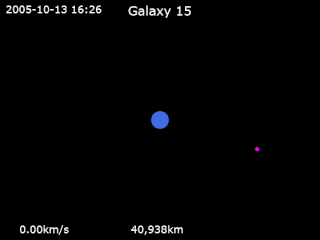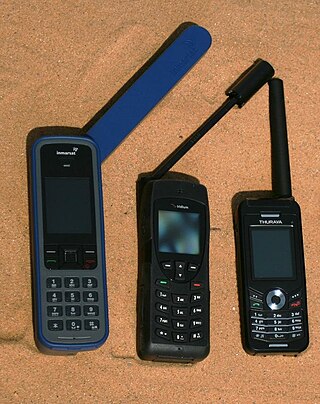Related Research Articles

Ariane 5 is a retired European heavy-lift space launch vehicle developed and operated by Arianespace for the European Space Agency (ESA). It was launched from the Guiana Space Centre (CSG) in French Guiana. It was used to deliver payloads into geostationary transfer orbit (GTO), low Earth orbit (LEO) or further into space. The launch vehicle had a streak of 82 consecutive successful launches between 9 April 2003 and 12 December 2017. Since 2014, Ariane 6, a direct successor system, is in development.

Intelsat S.A. is a multinational satellite services provider with corporate headquarters in Luxembourg and administrative headquarters in Tysons, Virginia, United States. Originally formed as International Telecommunications Satellite Organization, from 1964 to 2001, it was an intergovernmental consortium owning and managing a constellation of communications satellites providing international telecommunications and broadcast services.
Iridium Communications Inc. is a publicly traded American company headquartered in McLean, Virginia, United States. Iridium operates the Iridium satellite constellation, a system of 75 satellites: 66 are active satellites and the remaining nine function as in-orbit spares. Iridium Satellites are used for worldwide voice and data communication from handheld satellite phones, satellite messenger communication devices and integrated transceivers, as well as for two-way satellite messaging service from supported conventional mobile phones. The nearly polar orbit and communication between satellites via inter-satellite links provide global service availability.
The Ka band is a portion of the microwave part of the electromagnetic spectrum defined as frequencies in the range 26.5–40 gigahertz (GHz), i.e. wavelengths from slightly over one centimeter down to 7.5 millimeters. The band is called Ka, short for "K-above" because it is the upper part of the original NATO K band, which was split into three bands because of the presence of the atmospheric water vapor resonance peak at 22.24 GHz (1.35 cm), which made the center unusable for long range transmission. The 30/20 GHz band is used in communications satellite uplinks in either the 27.5 GHz or 31 GHz bands, and in high-resolution, close-range targeting radars aboard military airplanes. Some frequencies in this radio band are used for vehicle speed detection by law enforcement. The Kepler Mission used this frequency range to downlink the scientific data collected by the space telescope.

A military satellite is an artificial satellite used for a military purpose. The most common missions are intelligence gathering, navigation and military communications.
Orbital Sciences Corporation was an American company specializing in the design, manufacture, and launch of small- and medium- class space and launch vehicle systems for commercial, military and other government customers. In 2014, Orbital merged with Alliant Techsystems (ATK) to create a new company called Orbital ATK, which in turn was purchased by Northrop Grumman in 2018.

SES S.A., trading as SES is a Luxembourgish satellite telecommunications network provider supplying video and data connectivity worldwide to broadcasters, content and internet service providers, mobile and fixed network operators, governments and institutions.
ORBCOMM is an American company that offers industrial internet and machine to machine (M2M) communications hardware, software and services designed to track, monitor, and control fixed and mobile assets in markets including transportation, heavy equipment, maritime, oil and gas, utilities and government. The company provides hardware devices, modems, web applications, and data services delivered over multiple satellites and cellular networks.

Commercial use of space is the provision of goods or services of commercial value by using equipment sent into Earth orbit or outer space.

Inmarsat is a British satellite telecommunications company, offering global mobile services. It provides telephone and data services to users worldwide, via portable or mobile terminals which communicate with ground stations through fifteen geostationary telecommunications satellites.

Thales Alenia Space is a joint venture between the French technology corporation Thales Group (67%) and Italian defense conglomerate Leonardo (33%). The company is headquartered in Cannes, France.

Boeing 702 is a communication satellite bus family designed and manufactured by the Boeing Satellite Development Center, and flown from the late-1990s into the 2020s. It covers satellites massing from 1,500 kg (3,300 lb) to 6,100 kg (13,400 lb) with power outputs from 3 to 18 kW and can carry up to approximately 100 high-power transponders.

The Iridium satellite constellation provides L band voice and data information coverage to satellite phones, satellite messenger communication devices and integrated transceivers. Iridium Communications owns and operates the constellation, additionally selling equipment and access to its services. It was conceived by Bary Bertiger, Raymond J. Leopold and Ken Peterson in late 1987 and then developed by Motorola on a fixed-price contract from July 29, 1993, to November 1, 1998, when the system became operational and commercially available.

Galaxy 15 is an American telecommunications satellite which is owned by Intelsat. It was launched for and originally operated by PanAmSat, and was subsequently transferred to Intelsat when the two companies merged in 2006. It was originally positioned in geostationary orbit at a longitude of 133° West, from where it was used to provide communication services to North America.

Falcon Heavy is a heavy-lift launch vehicle with partial reusability that can carry cargo into Earth orbit, and beyond. It is designed, manufactured and launched by American aerospace company SpaceX.
The EELV Secondary Payload Adapter (ESPA) is an adapter for launching secondary payloads on orbital launch vehicles.
SES-5 is a commercial geostationary communication satellite operated by SES It was launched on 9 July 2012. The launch was arranged by International Launch Services (ILS).

Mobile-satellite service is – according to Article 1.25 of the International Telecommunication Union's Radio Regulations – "A radiocommunication service
References
- ↑ "Hosted Payloads – Office of Space Commerce" . Retrieved 2022-12-20.
- ↑ "What is a Hosted Payload?". Iridium Satellite Communications. 2018-08-21. Retrieved 2022-12-20.
- ↑ Office, U. S. Government Accountability. "Military Space Systems: DOD's Use of Commercial Satellites to Host Defense Payloads Would Benefit from Centralizing Data". www.gao.gov. Retrieved 2022-12-20.
- ↑ Meyerson, Hilary (2020-12-04). "Hosted Payloads Hitchhike to Space with Spaceflight's Sherpa OTVs". Spaceflight. Retrieved 2022-09-30.
- ↑ "Developments in hosted payloads" (PDF). Global Military Communications Magazine. 2018. Retrieved 2022-09-30.
- ↑ Space News
- ↑ "Intelsat Solutions: Hosted Payloads". INTELSAT. Retrieved January 25, 2023.
- ↑ de Selding, Peter B. (December 22, 2010). "Inmarsat Secures Ex-Im Financing for Global Xpress Satellites". Space News. Archived from the original on September 10, 2012.
- ↑ "DoD, Australia Sharing Hosted UHF Payload Space On Intelsat 22 Satellite". Defense Daily. 2012-03-30. Retrieved 2022-10-27.
- ↑ Andy Pasztor and Nathan Hodge (February 11, 2011). "Space Projects of Pentagon to Get Boost". The Wall Street Journal. Retrieved August 22, 2013.
- ↑ U.S. Air Force, SAIC, SES, and Orbital launch Commercially Hosted Infrared Payload Sensor infrared staring system aboard SES-2 satellite Military & Aerospace Electronics September 24, 2011. Accessed May 29, 2018
- ↑ "Iridium NEXT | Hosted Payloads". www.iridium.com. Archived from the original on 2010-03-04.
- ↑ GOLD [ permanent dead link ] NASA mission website. Accessed May 29, 2018
- ↑ SES-14 - Accompanying the opportunities in high growth markets in the Americas and North Atlantic SES. Accessed May 29, 2018
- ↑ ASTRA 5B's mission SES website. Accessed April 28, 2018
- ↑ SES-5 GEO Satellite Ensures EGNOS Services for the Long Term European Global Navigation Satellite Systems Agency September 4, 2015. Accessed May 29, 2018
- ↑ EGNOS on SES website Archived 2018-07-10 at the Wayback Machine SES. Accessed May 29, 2018
- ↑ Leidos bests Raytheon for FAA hosted payload contract Space News April 9, 2018. Accessed May 29, 2018
- ↑ New WAAS GEO Satellite Launch Federal Aviation Administration SatNavNews newsletter Spring 2017. Accessed May 29, 2018